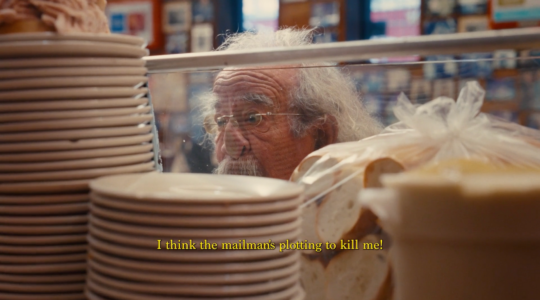After the 2002 Salute To Israel Parade, The New York Times published a clarification for a front-page photograph and article that focused, in an unbalanced way, on a handful of Palestinian protesters, relegating the 100,000 supporters of Israel to the background.
But a similar offense may have taken place in Times coverage (Oct. 11) of pro/anti Israeli activity at Rutgers University. Aside from allowing a misrepresentation of Hillel, the Jewish campus group, as having ìan extreme right-wing bias,î while ignoring support of violence by the Palestinian group, the article offers a photo, on the front page of the Metro section, in which an event that attracted some 4,000 Israeli supporters is seen through the prism of 100 anti-Israeli protesters in the foreground.
The most prominent voice in the article belongs to Abe Greenhouse, a student who in an act of what is gently described as ìincivilityî threw a pie in Natan Sharanskyís face during the Israeli cabinet ministerís September visit to the campus. The reporter, Maria Newman, then goes for a chuckle by pointing out that the pie was kosher. She allows Greenhouse to charge that Sharansky ìhas abandoned his commitment to human rights,î with no response from Sharansky or an advocate on his behalf.
Bill Borders, senior editor of The New York Times, told The Jewish Week, ìI donít see anything at all comparable to the serious mistake we made with our coverage of the Salute to Israel Parade.î The first Rutgers photo on page B1, says Borders, ìshows two Palestinians facing a couple of dozen obvious supporters of Israel. The picture on page B5 is entirely supporters of Israel, who, the caption makes clear, were overwhelmingly in the majority. The incident about the pie, which we did in fact report, scarcely redounds to the credit of Mr. Greenhouse.î
Borders points out that the 61 professors who criticized Hillel for what they called ìextreme-right biasî was followed by a reply from the Hillel president, and it quoted others as deploring pro-Palestinian terrorism.
Meanwhile, back in Israel, Sharansky, in his capacity as minister for Jerusalem and Diaspora Affairs, has taken up an impassioned defense of the Temple Mount, recently reopened to Jews after a three-year ban by Sharanskyís own government. Pointedly writing in Haaretz (Oct. 16), the most secular and leftist of Israeli papers, Sharanskyís op-ed was headlined: ìTemple Mount is more important than peace.î
The Israeli papers are divided. Hatzofeh praised a ruling by Orthodox rabbis that Jews ought to visit the Temple Mount, even as Yediot Achronot warned that this would be ìviewed by the Muslim world as a provocation.î Things have been heated lately, with Israeli police needing to fire tear gas and stun grenades to stop Arabs on the Mountís high ground from throwing rocks at the fleeing Jews in the Kotel plaza below.
Sharansky writes that even though peace advocate Yossi Beilin and ìthe same gang of Oslo blazersî are once again suggesting that giving up the Temple Mount is worth an end to war, ìif we totally relinquish every value for the sake of peace, we wonít have peace either.î Adds Sharansky, without ìcontinuity with the ancient kingdoms of Israel for whom the Temple Mount was the center of existence, we really are foreign invaders and colonialists in this country.î Subtract history and the religious imperative, and ìIsrael will become just another Jewish community,î not unlike New York or London, ìexcept more dangerous, less wealthy and less comfortable. … And if thatís the case, why continue to live in it? For what? In the name of what?î
Speaking of callousness to holy places, neither The Times, The Washington Post, nor most American papers, saw fit to carry a Reuters piece (Oct. 17) about Palestinians setting fire to Josephís Tomb last week, building a pyre of burning tires with flames tearing a large hole in the domed roof, and an Arab rampage that drove Jews away during the Sukkot holiday. Newspapers that regularly comment on Israelís damage to property and the ìhumiliationî of Palestinians, saw no need to editorialize about the humiliation of fleeing Jews, or that the rampages cast doubt on Israelís claim that it can be counted on to protect holy places.
In other rampages, The Atlanta Journal Constitution (Oct. 16) featured a first-person report by Rebecca Santana who fled a Palestinian mob in Gaza. While interviewing someone, she was kicked in the back of her legs: ìI could see some in the crowd heaving fist-size rocks.î She was hustled ìinside a bathroom to hide. I continued to hear the banging of rocks against the walls.î
Santana escaped. Others didnít. After last weekís Palestinian ambush that killed three Americans driving through Gaza, every paper reported Yasir Arafatís condemnation but not the newspaper columns and editorial cartoon in Al-Hayat Al-Jadeeda (Oct. 16), the official Palestinian paper that depicted the bombs with Jewish stars, with many columnists saying it was ìdoubtfulî the perpetrators were Palestinian.
Usually, when West Bank settlers are described in the general media as ìhotî and ìprovocative,î it is not in the erotic sense ó until now. A New York magazine cover feature on pornography (Oct. 20) had Naomi Wolf contrasting the sexual excess of American culture with the sexual modesty of an Orthodox Israeli woman whose ìwild, curly golden-blonde hairî is seen by no one but her husband. The writer found her to have an enviable ìcalm sexual confidence.î In her bedroom, in a settlement, ìthe sexual intensity in the air was archaic, overwhelming. It was private. It was a feeling of erotic intensity deeper than any I have ever picked up between secular couples in the liberated West. And I thought: Our husbands see naked women all day ó in Times Square if not on the Net. Her husband never even sees another womanís hair. She must feel, I thought, so hot.î n
Support the New York Jewish Week
Our nonprofit newsroom depends on readers like you. Make a donation now to support independent Jewish journalism in New York.
The New York Jewish Week brings you the stories behind the headlines, keeping you connected to Jewish life in New York. Help sustain the reporting you trust by donating today.




